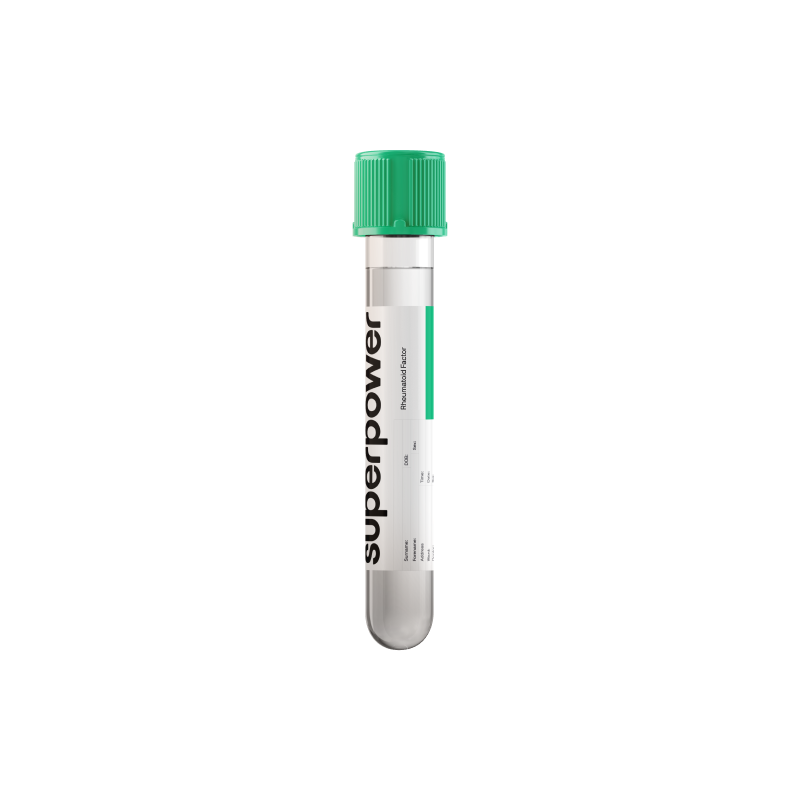Key Benefits
- Check for rheumatoid factor linked to rheumatoid arthritis.
- Clarify joint pain and morning stiffness by supporting or reducing suspicion for RA.
- Spot higher-risk disease when levels are high, suggesting aggressive, systemic RA.
- Guide timely rheumatology referral and early treatment to protect joints and function.
- Explain risks beyond the joints, like nodules or lung involvement, when strongly positive.
- Avoid misdiagnosis by considering other causes of positivity, like hepatitis C or Sjögren’s.
- Clarify long-term outlook; positive results predict joint damage risk more than flares.
- Best interpreted with anti-CCP, ESR/CRP, imaging, and your symptoms.
What is Rheumatoid factor?
Rheumatoid factor (RF) is an autoantibody that recognizes other antibodies. Most often it is an IgM antibody that binds to the tail end (Fc region) of IgG. It is produced by B lymphocytes that have matured into plasma cells, typically within lymphoid tissues such as lymph nodes and bone marrow, and, during chronic inflammation, in the lining of joints (synovium). Some RF can be of other classes, such as IgA or IgG, but they share the same target: the Fc portion of IgG.
RF’s main significance is that it reflects self-directed immune activity and immune complex formation. By binding to IgG, RF can link antibodies together, creating immune complexes that circulate or settle in tissues. These complexes can turn on the complement system and attract white blood cells, amplifying local inflammation. In everyday biology RF has no essential protective role; rather, it marks and contributes to a feedback loop of antibody–antibody binding that can sustain inflammation, particularly in synovial tissue.
Why is Rheumatoid factor important?
Rheumatoid factor (RF) is an autoantibody—most often IgM—that targets the Fc portion of IgG. When present, it signals a B‑cell–driven immune process that can form immune complexes, activate complement, and inflame tissues. That is why RF is used to support a diagnosis of rheumatoid arthritis and to flag systemic involvement that can reach beyond joints to blood vessels, lungs, eyes, and nerves.
Most labs define a negative or below‑cutoff result as typical, and the healthiest pattern is at the low end. RF isn’t required for health, so “optimal” is essentially undetectable.
When RF is low or undetectable, it reflects little immune‑complex activity and minimal complement activation. People generally have no RF‑related symptoms. Important nuance: some individuals with rheumatoid arthritis are “seronegative,” especially early in disease, so normal RF does not exclude inflammatory joint disease. In children, arthritis often occurs without RF; RF positivity in youth is uncommon.
When RF is elevated, the immune system is producing autoantibodies that can cluster with IgG and deposit in synovium, driving morning stiffness, swollen tender joints, and fatigue. Higher titers correlate with more erosive joint damage and extra‑articular features such as rheumatoid nodules, vasculitis, scleritis, and interstitial lung disease. Levels can also rise in other conditions—chronic infections (for example, hepatitis C), chronic liver and lung disease, and with aging—so RF is supportive, not definitive. In women, who develop RA more often, higher RF can track with more aggressive disease; in adolescents, RF positivity suggests a more severe polyarticular course.
Big picture: RF sits at the crossroads of humoral immunity, immune‑complex biology, and tissue inflammation. Interpreted with symptoms and related markers (anti‑CCP, ESR, CRP), it helps gauge systemic inflammatory burden and long‑term risks such as joint destruction, extra‑articular disease, and cardiovascular complications.
What Insights Will I Get?
Rheumatoid factor (RF) measures autoantibodies—most often IgM—that target the Fc portion of IgG. It signals a breakdown in immune tolerance that can form immune complexes, activate complement, and drive inflammation in joints and throughout the body. Systemically, higher RF activity can amplify inflammatory load, affecting energy, vascular health, and, in severe cases, cognition via cytokine signaling.
Low values usually reflect minimal or absent RF activity and a low burden of immune complexes. This generally indicates intact B‑cell tolerance. Absence of RF does not rule out inflammatory arthritis; early rheumatoid arthritis and many juvenile cases can be “seronegative.”
Being in range suggests balanced immune surveillance without evidence of RF‑mediated autoimmunity. It implies stable connective tissue and vascular signaling with lower systemic inflammatory tone. For most labs, optimal sits at the low end—often undetectable—rather than mid‑range.
High values usually reflect ongoing B‑cell activation against self‑IgG with immune‑complex formation and complement consumption. This is classically seen in rheumatoid arthritis and Sjögren’s, but can also occur with chronic infections (notably hepatitis C), certain lung diseases, and with aging. System effects can include synovial inflammation, fatigue, anemia of inflammation, and increased cardiovascular risk; higher titers and IgA RF correlate with extra‑articular disease and are more common in smokers.
Notes: Interpretation varies by assay and RF isotype. Modest elevations are more frequent in older adults and may be nonspecific. Levels can fluctuate with intercurrent infection and often decline in pregnancy. Immunosuppressive therapies can lower RF. RF negativity does not exclude, and positivity alone does not establish, rheumatoid arthritis; correlation with symptoms and other markers (e.g., anti‑CCP, CRP, imaging) is essential.



.svg)



.png)
.png)
.png)
.png)








